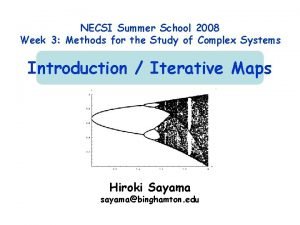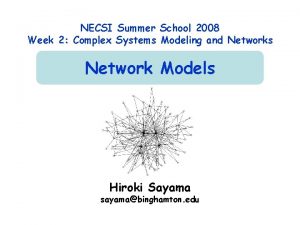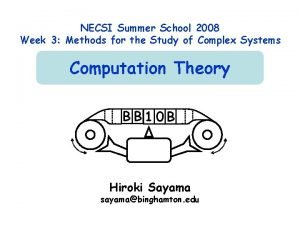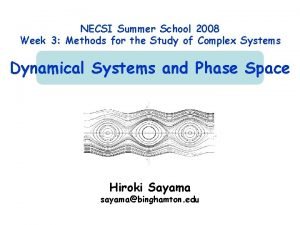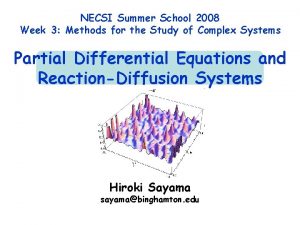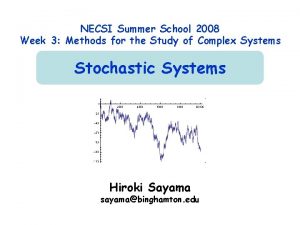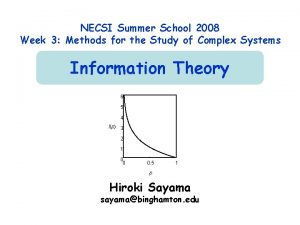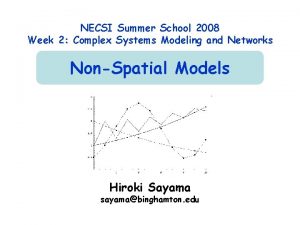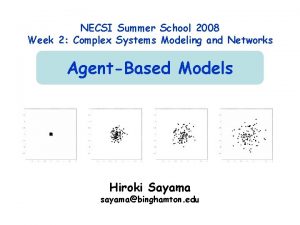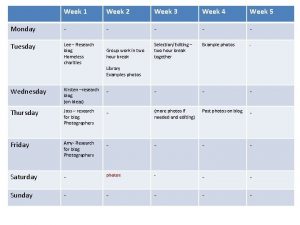NECSI Summer School 2008 Week 3 Methods for












































































- Slides: 76

NECSI Summer School 2008 Week 3: Methods for the Study of Complex Systems Analytical Tools for Dynamical Systems Hiroki Sayama sayama@binghamton. edu

Four approaches to complexity Nonlinear Dynamics Complexity = No closed-form solution, Chaos Computation Complexity = Computational time/space, Algorithmic complexity Information Complexity = Length of description, Entropy Collective Behavior Complexity = Multi-scale patterns, Emergence 2

Local Linearization and Linear Stability Analysis 3

Stability of equilibrium points • If a system at its equilibrium point is slightly perturbed, what happens? • The equilibrium point is called: – Stable (or asymptotically stable) if the system eventually falls back to the equilibrium point – Lyapunov stable if the system doesn’t go far away from the equilibrium point – Unstable otherwise 4

Question • What is the stability of each of the following equilibrium points? 5

Linear stability analysis • Studies whether a nonlinear system is stable or not at its equilibrium point by locally linearizing its dynamics around that point Linearization 6

Local linearization (1) • Let Dx be a small difference between the system’s current state x and its equilibrium point xe, i. e. x = xe +Dx • Plug x = xe + Dx into differential equations and ignore quadratic or higher-order terms of Dx (hence the name “linearization”) 7

Local linearization (2) • This operation does the trick to convert the dynamics of Dx into a product of a matrix and Dx ! • By analyzing eigenvalues of the matrix, one can predict whether xe is stable or not – I. e. whether a small perturbation (Dx) grows or shrinks over time 8

Mathematically speaking… • This operation is similar to “linear approximation” in calculus Taylor series expansion: F(x) = Sn=0~ F(n)(a)/n! (x-a)n Let x xe+Dx and a xe , then F(xe+Dx) = F(xe) + F’(xe) Dx + O(Dx 2) Ignore 9

Linearizing discrete-time models • For discrete-time models: xt = F(xt-1) Left = xe + Dxt Right = F(xe + Dxt-1) ~ F(xe) + F’(xe) Dxt-1 = xe + F’(xe) Dxt-1 Therefore, Dxt = F’(xe) Dxt-1 10

Linearizing continuous-time models • For continuous-time models: dx/dt = F(x) Left = d(xe + Dx)/dt = d. Dx/dt Right = F(xe + Dx) ~ F(xe) + F’(xe) Dx = F’(xe) Dx Therefore, d. Dx/dt = F’(xe) Dx 11

First-order derivative of vector functions • Discrete-time: Dxt = F’(xe) Dxt-1 • Continuous-time: d. Dx/dt = F’(xe) Dx These can hold even if x is a vector What corresponds to the first-order derivative in such a case: F 2 x 1 F 2 … x 2 xn … Fn x 1 … e F 1 … x 2 xn … F’(xe) = d. F/dx(x=x ) = F 1 x 1 Fn … Fn x 2 xn Jacobian matrix at x=xe (x=xe) 12

Obtain Jacobian matrices of the Lotka. Volterra model around its equilibrium points Exercise dx/dt = a x – b x y dy/dt = - c y + d x y (a, b, c, d>0) Positive influence Rabbit Population : x + Naturally grows if isolated - + Fox Population : y Negative influence - Naturally decays if isolated 13

Eigenvalues of Jacobian matrix • A Jacobian matrix is a linear approximation around the equilibrium point, telling you the local dynamics: “how a small perturbation will grow, shrink or rotate around that point” – The equilibrium point serves as a local origin – The Dx serves as a local coordinate – Eigenvalue analysis applies 14

Review: What eigenvalues and eigenvectors can tell us • An eigenvalue tells whether a particular “state” of the system (specified by its corresponding eigenvectors) grows or shrinks by interactions between parts – | l | > 1 -> growing for discrete-time cases – | l | < 1 -> shrinking – Re(l) > 0 -> growing for continuous-time cases – Re(l) < 0 -> shrinking 15

With real eigenvalues • If all the eigenvalues indicate that Dx will shrink over time -> stable point • If all the eigenvalues indicate that Dx will grow over time -> unstable point • If some eigenvalues indicate shrink and others indicate grow of Dx over time -> saddle point (this is also unstable) 16

With two complex conjugate eigenvalues (for 2 -D systems) • If both eigenvalues indicate that Dx will shrink over time -> stable spiral focus • If both eigenvalues indicate that Dx will grow over time -> unstable spiral focus • If both eigenvalues indicate neither shrink nor growth of Dx -> neutral center (but this may or may not be true for nonlinear models; further analysis is needed to check if nearby trajectories are truly cycles or not) 17

With real and complex eigenvalues mixed (for higher-dimm. systems) • Each eigenvalue (or a pair of complex conjugate eigenvalues) tell you distinct dynamics simultaneously seen at the equilibrium point: All real eigenvalues (1 indicates growth; other 2 indicates shrink) 1 real eigenvalue indicates growth; other 2 indicates rotation (complex conjugates with no growth or shrink) 18

Exercise • Evaluate the stabilities of equilibrium points of the Lotka-Volterra model using eigenvalue analysis of Jacobian matrices • Do the same analysis for the revised version with carrying capacity and upper bound of predation rate 19

Bifurcations 20

Bifurcation • Topological change of phase space that occurs when some control parameter is varied – Local bifurcation (change in stability of equilibrium points) – Global bifurcation (collision of invariant sets; not covered in this course) 21

Bifurcations in complex systems • Often play important roles as a switching mechanism that causes abrupt changes of systems’ behavior from one to another – Conformation switching of proteins and other biopolymers – Neural switching (resting/excited) – Pattern formation in morphogenesis (will be discussed later) 22

When bifurcation occurs in nonlinear systems • { li }: eigenvalues of Jacobian matrix at equilibrium point xe • xe is: – Stable if |li| < 1 for all i or if Re(li) < 0 for all i – Unstable if |li| > 1 for some i or if Re(li) > 0 for some i (discrete-time) (continuous-time) • Bifurcation occurs when the above inequalities become equations, i. e. , when the stability of an equilibrium point changes – |li| = 1 or Re(li) = 0, for some i (discrete-time) (continuous-time) 23

Bifurcations in 1 -D Systems 24

Bifurcations in 1 -D systems • Phase space of a 1 -D system is given by the locations of equilibrium points and directions of flows between them • Bifurcation occurs when equilibrium points appear, disappear or change their stabilities – E. g. saddle-node bifurcation of a 1 -D system 25

When bifurcation occurs in 1 -D nonlinear systems • Equilibrium point xe is: – Stable if | F/ x(x=xe)| < 1 or if F/ x(x=xe) < 0 – Unstable if | F/ x(x=xe)| > 1 or if F/ x(x=xe) > 0 (discrete-time) (continuous-time) • No need to take Re() because complex conjugate eigenvalues require at least two dimensions • Bifurcation occurs when the above inequalities become equations – | F/ x(x=xe)| = 1 or F/ x(x=xe) = 0 (discrete-time) (continuous-time) 26

Bifurcation diagram x Vertical axis: location(s) of equilibrium points r Horizontal axis: control parameter • Can be used only for 1 -D systems, but still conceptually helpful • Here stable equilibrium points shown in blue lines; unstable ones in red lines 27

Saddle-node bifurcation • A pair of stable and unstable equilibrium points emerge (or vanish) Example: dx/dt = r – x 2 Control parameter Phase space 28

Transcritical bifurcation • One equilibrium point passes through another, exchanging the stabilities Example: dx/dt = rx – x 2 Control parameter Phase space 29

Pitchfork bifurcation • A stable point splits into two (with one unstable point also emerging) Example: dx/dt = rx – x 3 Control parameter Phase space 30

Other bifurcations • Bifurcation with two control parameters Example: dx/dt = k + rx – x 3 (left: k=2; right: r=5) – This type of bifurcation is important in studying catastrophic behavior • Subcritical pitchfork bifurcation Example: dx/dt = rx + x 3 31

Exercise: Two competing species • Two species “x” and “y” compete for a finite resource or habitat • Total population is assumed constant x + y = K (i. e. , the systems is 1 -D) • Growth is influenced by their relative population difference: dx/dt = a x (1 - x/K) (x – y)/K • Obtain equilibrium points of this system and their stabilities 32

Exercise: Two competing species • Assume this system is connected to a much larger population where their ratio is always maintained 50 -50: dx/dt = a x (1 - x/K) (x – y)/K + r (0. 5 – x/K) (r: strength of connection, or diffusion coefficient) • Determine when bifurcation occurs in this system and draw its bifurcation diagram over varying r 33

Review: Period-doubling bifurcation • Period-doubling bifurcations in discrete-time models occur when F/ x(x=xe) = -1 – The equilibrium point is about to destabilize in a flipping manner – e. g. Logistic map: xt = r xt-1 (1 – xt-1) 34

Limit Cycles and Hopf Bifurcations in Higher-Dimensional Systems 35

Limit cycle • A cyclic (closed) trajectory in phase space defined as an asymptotic limit of other spiral trajectories nearby – Stable (or attracting) cycle limit – Unstable limit cycle – Metastable 36

Example: van der Pol oscillator • A dynamical model that appears in electric circuit theory d 2 x/dt 2 + l(x 2 – 1) dx/dt + x = 0 – Convert this model into a first-order form – Obtain an equilibrium point and its stability – Draw phase portraits with l = -1, 0, 1 37

Example: Cycles in Lotka-Volterra models • Original model: dx/dt = a x – b x y dy/dt = - c y + d x y – This does have cyclic trajectories, but they are NOT limit cycles • Revised model: dx/dt = a x (1 -x/K) – b Jx/(J+x) y dy/dt = - c y + d Jx/(J+x) y – This may have a stable limit cycle depending on parameter values 38

Example: Limit cycle in the revised Lotka-Volterra model • Draw a rough phase portrait of the revised Lotka-Volterra model with a=1, b=1. 5, c=0. 5, d=1, J=1, K=4 • Analyze the stability of its non-zero equilibrium point with the parameter values given above 39

Hopf bifurcation • Typical scenario: A stable equilibrium point “explodes” to create a limit cycle; only possible in 2 -D or higher dimensions • Occurs when |li| = 1 (discrete-time) or Re(li) = 0 (continuous-time) for some i and when these l’s have imaginary parts 40

Exercise: Hopf-bifurcation in the revised Lotka-Volterra model • Analyze the stability of the non-zero equilibrium point of the revised Lotka. Volterra model with a=1, b=1. 5, c=0. 5, d=1, K=4, while leaving J as a variable (control parameter) • Figure out at what value of J the system undergoes Hopf bifurcation • Plot several phase portraits with varying J near its critical value 41

Hopf Bifurcations in Neuronal Models 42

Neuron • Axon terminals are connected to other neurons (connection called synapses) • A neuron may have more than 10, 000 connections • An axon may be several feet long 43

How a neuron works • Receives neurotransmitters from other neurons (either excitatory or inhibitory) • Becomes temporarily excited (depolarized) when accumulated stimuli exceeds a threshold • Depolarized action potential is propagated along the axon, and then releases new neurotransmitters to other neurons 44

Hopf bifurcations in neural models • Switching between resting and excited (depolarized) states of action potential can be understood as a Hopf bifurcation • Input stimuli serves as control parameter 45

Classic model: Hodgkin-Huxley equations active • An experimentally developed model of neuronal dynamics based on electric circuit analogs • All trajectories converge toward a stable resting state in 4 -D phase space absolutely refractory regenerative resting state relatively refractory 46

Simplified illustrative model: Fitz. Hugh-Nagumo equations • x: voltage, y: recovery variable, z: external stimuli • A simplified model of the H-H equations developed after the van der Pol equation • Not necessarily captures the actual physiological mechanisms, but nicely illustrates the dynamics of neural excitation via Hopf bifurcations 47

Exercise • Assume a=0. 7, b=0. 8 and c=3 • Obtain analytically the equilibrium point of the F-N equations (there is only one real equilibrium point) • Evaluate the stability of that point • Identify when Hopf bifurcation occurs 48

Chaos in Continuous-Time Models 49

Chaos in continuous-time models • Requires three or more dimensions – Because in 1 -D or 2 -D phase space, every trajectory works as a “wall” and thus confines where you can go in the future; stretching and folding are not possible in such an environment TRON / © Walt Disney Pictures 50

Edward N. Lorenz’s model • A model of fluid convection: dx/dt = s (y – x) dy/dt = r x – y – x z dz/dt = x y – b z (s, r and b are positive parameters) • Typical behavior (x plotted over time): 51

Exercise • Obtain the equilibrium points of the Lorenz model as a function of r while keeping s = 10 and b = 8/3 • Examine their stability and its dependence on the value of r • When do bifurcations occur? 52

Exercise • Draw phase portraits of the Lorenz model by either projecting it to a 2 -D space or plotting in a 3 -D space – Not to mess up the plot, it is suggested that you plot only one sample trajectory starting from a single initial condition • Try several different values of r and see what you will get 53

Phase portrait 54

Strange attractor • A bounded region in a phase space that attracts nearby trajectories but also exhibits sensitive dependence on initial conditions inside it (i. e. , no convergence to fixed points or periodic trajectories) – A. k. a. : chaotic attractor, fractal attractor 55

Exercise: Finding stretch and folding in the Lorenz model • Interpret the structure of the strange attractor of the Lorenz model and find how “stretch and folding” of phase space is achieved 56

Exercise: Finding hidden order in chaotic systems • Let zi denote the value of i-th peaks of z in the Lorenz model: z 1 z 2 z 3 z 4 z 5 z 6 … • Obtain time series data { zi } from numerical results (this may require some programming), draw a “zt-1 vs. zt” plot, and discuss what is seen there 57

Mean-Field Approximation (will be revisited later) 58

Limitations of phase space-based approaches • Phase space visualization is impossible for high-dimensional systems – E. g. models with 20 variables, either continuous or discrete • Some phase space analysis techniques works for continuous models only – E. g. linear stability analysis does not work for discrete-state models where infinitely small noise cannot be assumed 59

Difficulty in high-dimensional phase space • Drawing a complete phase space is impractical when a system has many degrees of freedom E. g. Contact network of 100 people; each can be either healthy or sick # of states: 2100 ≒ 1030 !! 60

Mean-field approximation • An approximation to drastically reduce the dimensions of the system by reformulating the dynamics in terms of “a state of one node” and “the average of all the rest (= mean field)” Healthy MFA A node Sick 61

How MFA works Healthy MFA A node Sick 1. Make an approximated description about how one node changes its state through the interaction with the average of all the rest (= mean field) 2. Assume that 1. uniformly applies to all the nodes, and analyze how the mean field itself behaves 62

Mathematical description of MFA (difference equations) • Original equations: xit = Fi( { xit-1 } ) • Approximate equations with MFA: xit = F’i(xit-1, <x>t-1) <x>t = Si xit-1 / n Each state-transition function takes only two arguments: its own state and the “mean field” 63

Example • Majority game played by many agents – n agents, whose state xit is either 0 or 1 – Each agent looks at the states of other k agents and changes its state to the major choice among them (without looking at its current state) MFA Let pt be an average ratio of choice 1 in the system, and assume that edges are connected at random 64

Exercise • Describe the probability for choice 1 to be a majority among the k other agents using pt • Write down a MFA version of the state-transition equations • Consider how the mean field pt changes along time 65

Answer • Probability for choice 1 to be a majority among the k other agents: rt = Sk/2<m<=k m (1 -p )k-m C p k m t t • State-transition equations: x it = 1 (with prob. rt-1) or 0 (otherwise) • Change of the mean field pt: pt = Si xit / n = rt-1 (if n is large) = Sk/2<m<=k k. Cm pt-1 m (1 -pt-1)k-m 66

Predicted behavior pt = Sk/2<m<=k m (1 -p k-m C p ) k m t-1 1 1 1 0. 5 0 1 2 3 4 5 6 k=3 7 8 9 10 0 1 2 3 4 5 6 k=5 7 8 9 10 0 1 2 3 4 5 6 7 8 9 k=7 It is predicted that the greater range of local friendship each agent has, the faster the entire system converges to one choice 67 10

Exercise • Consider the propagation of flu over a large social network in which people are randomly connected to others • A pair of people are connected with each other at small probability p • Flu infects from an infected person to her susceptible neighbors at 100% probability • An infected person will immediately come back to susceptible at next time step thanks to medication (but no immunity acquired; SIS model) 68

Exercise • Assume there are n people in total, and there is only one infected person at the beginning • Describe how the ratio of infected people changes over time using MFA – What is the critical value of p? – State of each person: { 0, 1 } (0: susceptible, 1: infected) – Mean field variable: rt (Ratio of infected people within society) 69

Exercise • If you randomly pick another person, how likely is it that you and that person are connected AND she is infected? p rt • What is the probability for you NOT to have even a single infected neighbor? (1 - p rt)n-1 70

Exercise • Think about transition probabilities xit-1 x it Transition probability 0 0 1 1 0 1 (1 - p rt-1)n-1 1 - (1 - p rt-1)n-1 1 0 71

Exercise xit-1 x it Transition probability 0 0 1 1 0 1 (1 - p rt-1)n-1 1 - (1 - p rt-1)n-1 1 0 • Based on the above result, describe time evolution of rt: rt = (1 - rt-1) ( 1 - (1 - p rt-1)n-1 ) Initial condition: r 0 = 1/n 72

Exercise • What is the critical connection probability pc? – With pc, r stays its initial value (r 0) r 0 = (1 - r 0) ( 1 - (1 - pc r 0)n-1 ) – As pc r 0 is small, we may write: r 0 ~ (1 - r 0) ( 1 - (n - 1) pc r 0) ) pc ~ 1 / (1 - r 0) (n - 1) = n / (n - 1)2 73

Exercise Numerical simulation results with n=1000, r 0 = 1/n 1 0. 8 p=0. 015 0. 6 p=0. 01 p=0. 005 p=0. 003 0. 4 p=0. 002 p=0. 0015 0. 2 p=0. 001 0 0 10 20 74

Applicability of MFA • Works quite well when applied to wellconnected or random systems • May not work if connections are local and/or inhomogeneous, or if a system has a non-uniform “pattern” as its state 75

Summary • To study the dynamics of nonlinear systems, there are several analytical tools available: – Linear stability analysis – Bifurcation analysis – Mean-field approximation 76
 Necsi
Necsi Necsi
Necsi Necsi
Necsi 2008 2008
2008 2008 Week by week plans for documenting children's development
Week by week plans for documenting children's development Lodi unified school district summer school
Lodi unified school district summer school Crescenta valley high school summer school
Crescenta valley high school summer school Assignment in spanish
Assignment in spanish Wax pattern in dentistry
Wax pattern in dentistry 2008-2009 school year
2008-2009 school year High school 2008 fashion
High school 2008 fashion Iso 22301 utbildning
Iso 22301 utbildning Novell typiska drag
Novell typiska drag Tack för att ni lyssnade bild
Tack för att ni lyssnade bild Returpilarna
Returpilarna Shingelfrisyren
Shingelfrisyren En lathund för arbete med kontinuitetshantering
En lathund för arbete med kontinuitetshantering Underlag för särskild löneskatt på pensionskostnader
Underlag för särskild löneskatt på pensionskostnader Vilotidsbok
Vilotidsbok Sura för anatom
Sura för anatom Vad är densitet
Vad är densitet Datorkunskap för nybörjare
Datorkunskap för nybörjare Tack för att ni lyssnade bild
Tack för att ni lyssnade bild Att skriva en debattartikel
Att skriva en debattartikel För och nackdelar med firo
För och nackdelar med firo Nyckelkompetenser för livslångt lärande
Nyckelkompetenser för livslångt lärande Påbyggnader för flakfordon
Påbyggnader för flakfordon Lufttryck formel
Lufttryck formel Offentlig förvaltning
Offentlig förvaltning Kyssande vind analys
Kyssande vind analys Presentera för publik crossboss
Presentera för publik crossboss Teckenspråk minoritetsspråk argument
Teckenspråk minoritetsspråk argument Vem räknas som jude
Vem räknas som jude Treserva lathund
Treserva lathund Luftstrupen för medicinare
Luftstrupen för medicinare Claes martinsson
Claes martinsson Cks
Cks Programskede byggprocessen
Programskede byggprocessen Bra mat för unga idrottare
Bra mat för unga idrottare Verktyg för automatisering av utbetalningar
Verktyg för automatisering av utbetalningar Rutin för avvikelsehantering
Rutin för avvikelsehantering Smärtskolan kunskap för livet
Smärtskolan kunskap för livet Ministerstyre för och nackdelar
Ministerstyre för och nackdelar Tack för att ni har lyssnat
Tack för att ni har lyssnat Referatmarkering
Referatmarkering Redogör för vad psykologi är
Redogör för vad psykologi är Stål för stötfångarsystem
Stål för stötfångarsystem Atmosfr
Atmosfr Borra hål för knoppar
Borra hål för knoppar Vilken grundregel finns det för tronföljden i sverige?
Vilken grundregel finns det för tronföljden i sverige? Formel standardavvikelse
Formel standardavvikelse Tack för att ni har lyssnat
Tack för att ni har lyssnat Steg för steg rita
Steg för steg rita Verksamhetsanalys exempel
Verksamhetsanalys exempel Tobinskatten för och nackdelar
Tobinskatten för och nackdelar Toppslätskivling dos
Toppslätskivling dos Handledning reflektionsmodellen
Handledning reflektionsmodellen Egg för emanuel
Egg för emanuel Elektronik för barn
Elektronik för barn Fredsgudinna
Fredsgudinna Strategi för svensk viltförvaltning
Strategi för svensk viltförvaltning Var 1721 för stormaktssverige
Var 1721 för stormaktssverige Humanitr
Humanitr Ro i rom pax
Ro i rom pax Tack för att ni lyssnade
Tack för att ni lyssnade Avrunda decimaltal
Avrunda decimaltal Bunden eller fri form
Bunden eller fri form Inköpsprocessen steg för steg
Inköpsprocessen steg för steg Rbk-mätning
Rbk-mätning Ledarskapsteorier
Ledarskapsteorier Vad är hsil
Vad är hsil Myndigheten för delaktighet
Myndigheten för delaktighet Frgar
Frgar Tillitsbaserad ledning
Tillitsbaserad ledning Läkarutlåtande för livränta
Läkarutlåtande för livränta Karttecken sten
Karttecken sten Geometri för barn
Geometri för barn
